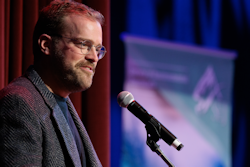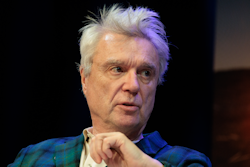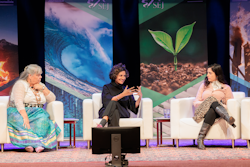SEJournal Online is the digital news magazine of the Society of Environmental Journalists. Learn more about SEJournal Online, including submission, subscription and advertising information.
 |
 |
| Prominent journalists joined a panel discussion on the year ahead in environmental reporting. From left to right, NBC’s Chase Cain, WUSF’s Jessica Meszaros, The Arizona Republic’s Deb Krol, The New York Times’ Somini Sengupta, Mongabay’s Karla Mendes, Inside Climate News’ Victoria St. Martin and TIME Magazine’s Justin Worland. Photo: The George Washington University. |
SEJ News: Gathering Offers Sobering Look Ahead at 2024, But With Glimmers of Hope
By Joseph A. Davis
 |
The year 2024 will be loaded with environmental news and reporting opportunities, particularly around worsening climate change, a panel of seasoned journalists told an audience of nearly 500 at the annual Society of Environmental Journalists “Journalists’ Guide to Environment and Energy” event on Nov 16.
The climate crisis, the coming election and the right to a livable environment for marginalized people are among the top issues that will confront environmental journalists, said speakers (watch the video here).
The program, hosted by Planet Forward at The George Washington University in Washington, D.C., with sponsorship and support from the Wilson Center and the Walton Family Foundation, drew more than 250 in-person attendees and 220 for a livestream.
Luke Runyon, longtime public radio reporter and president of the Society of Environmental Journalists, who emceed the gathering, opened on a sobering note.
 |
| Luke Runyon. Photo: The George Washington University. |
“While the need and demand for environmental journalism has never been higher,” said Runyon, “the future of environmental journalism is frankly a little cloudy due to the industry’s economic upheavals and other threats like attacks on journalists, difficult working conditions and a lack of diversity in the field.”
Runyon also summarized SEJournal’s Journalists’ Guide special report, particularly its overview of the United Nations annual climate change negotiating session, COP28, beginning later this month in Dubai.
“If the future of the world’s warming climate depends on the outcome of the coming [COP28], strap in for a bumpy ride,” he said. “For anyone who cares about climate change, COP28 is what you could call a do-or-die moment. Global heating is happening now, and the effects are disastrous. But even so, the question remains whether the world's nations will make a firm commitment to end nearly all fossil fuel burning.”
‘There are things that are inspiring’
Media doomscrollers in the audience, however, were treated to some welcome relief from a literal rock star, David Byrne, who spoke about the “self-therapy” origins of his solutions journalism-oriented online news magazine Reasons to be Cheerful.
 |
| David Byrne. Photo: The George Washington University. |
“The negativity bias is a big deal. We’ve evolved as a species … to be aware of negative things in the environment around us,” Byrne noted. “So it’s a little bit of an uphill battle getting people to read good news, but once they find it, they find it, as it has been for me, very therapeutic.”
Byrne, who was interviewed by the publication’s executive editor, Will Doig, gave examples of the kinds of articles the service shared daily.
Among them was one on how red state Texas gets more of its energy from wind than any other state in the United States, while another shared data showing that the vast majority of fish stocks are no longer overfished in U.S. waters.
‘It’s not like we’re done and dusted. …
But there are things that are inspiring.’
— David Byrne
But Byrne acknowledged that serious problems, such as international overfishing, continue, so “it’s not like we’re done and dusted. … But there are things that are inspiring.”
A similarly positive message, about the power of storytelling, came from a young Indigenous reporter, Shondiin Mayo, who was interviewed by Frank Sesno, GWU professor and head of Planet Forward.
“As a Native person, storytelling is everything,” said Mayo, who grew up in a rural Alaskan village. “It’s what we do, it’s who we are, it’s how we tell our history, and it’s how we know ourselves in our land around us and it’s how we relate to other people.”
Covering climate’s local, compound effects
 |
| St. Martin, left, and Worland. Photo: The George Washington University. |
At the panel discussion that followed, half a dozen prominent journalists, including moderator Justin Worland of TIME magazine, shared their take on what was ahead in 2024 environmental and energy news and how to cover it.
Jessica Meszaros, sustainability reporter for WUSF Public Media in Florida, spoke of how global issues would impact the environment on a more localized level, such as record-breaking ocean temperatures bringing about great damage to coral reefs there.
She also spoke of how climate change was increasing people’s energy burden. “Electric bills have gone up 62% in four years,” Meszaros said, “and basically people who are making less money are now having to take the brunt of this. Some people are paying upwards of 11% of their income … toward electricity.”
Meszaros also noted that rising storm threats from climate change have also driven insurance rates up dramatically.
NBC News national climate reporter and meteorologist Chase Cain said that the current El Niño weather pattern was going to continue as a major factor next year and cited a recent World Meteorology Association report that found El Niño would amplify climate effects like droughts, heat waves and floods.
He added that the just-published U.S. National Climate Assessment dedicated a whole chapter to “compound events.” “So then a hurricane comes through and then right behind it, you have a heat wave,” Cain said. “Now you have people trying to recover from a hurricane or from flooding without power in a heat wave.”
‘Now that we know, what do we do?’
Climate change was also preeminent on the 2024 agenda for Somini Sengupta, global climate correspondent for The New York Times.
 |
| (From left to right) Krol, Sengupta and Mendes. Photo: The George Washington University. |
“Climate change is altering the basics of human life — at the community level, at the national level, at the geopolitical level,” Sengupta said. “And I do think it’s on us as journalists to help explain, ‘OK, now that we know, what do we do? And what are people trying to do to meet this moment? Who are those interesting innovators, leaders, change makers?’”
But other critical issues need covering as well, it was clear from various panelists’ story lists. Debra Krol, Indigenous affairs reporter at The Arizona Republic, even as she spoke to the centrality of climate change, has been reporting a great deal on water.
She said her paper will soon begin publishing her series on the Klamath River, reporting on the “decades-long effort to restore the river system. … We're covering what led up to that and what’s going to follow that, the continuing effort to reimagine Colorado River water allocations, what that means for the tribes that hold the senior water rights.”
‘It’s really important to
think about the preservation
of our forests and our biomes.’
— Karla Mendes
Karla Mendes of Brazil, an investigative reporter for Mongabay and a member of the SEJ board, said “It’s really important to think about the preservation of our forests and our biomes. Although the Amazon is based in Brazil, it’s important for the world.”
Mendes added that she will also be investigating the supply chain, “because several commodities from the Amazon — timber, beef, gold — they go mostly to the U.S., Europe, China.”
Consumer environmental angles are also a focus for Victoria St. Martin, a health and environmental justice reporter for Inside Climate News, who as an example pointed to the U.S. Food and Drug Administration’s recent proposal to ban the carcinogenic formaldehyde in chemical hair straighteners, a product used by some Black women.
St. Martin is also tracking other kinds of air pollution, particularly their effects on children, who are more vulnerable because their lungs have yet to develop. She also expects to spend more time covering gas stoves, which some states and agencies are concerned about because they can cause harmful indoor air pollution. “There’s a wealth of stories to tell there,” she said.
The event concluded with the announcement of the SEJ’s top award winner for reporting on the environment. The winner of the 2023 Nina Mason Pulliam Award, Runyon announced, is "The Amazon, Undone" by Terrence McCoy, Júlia Ledur and Cecília do Lago, with photos by Raphael Alves and Rafael Vilela, for The Washington Post. Honorable mention also went to a team of students at Arizona State University's Walter Cronkite School of Journalism and Mass Communication for "Gaslit." You can learn more about these projects here.
Joseph A. Davis is a freelance writer/editor in Washington, D.C. who has been writing about the environment since 1976. He writes SEJournal Online's TipSheet, Reporter's Toolbox and Issue Backgrounder, and curates SEJ's weekday news headlines service EJToday and @EJTodayNews. Davis also directs SEJ's Freedom of Information Project and writes the WatchDog opinion column.
* From the weekly news magazine SEJournal Online, Vol. 8, No. 42. Content from each new issue of SEJournal Online is available to the public via the SEJournal Online main page. Subscribe to the e-newsletter here. And see past issues of the SEJournal archived here.













 Advertisement
Advertisement 



